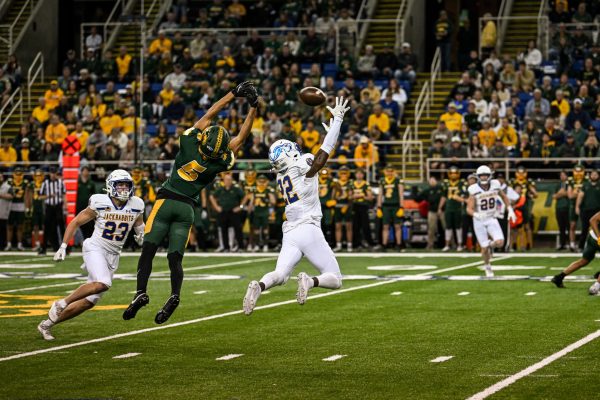What will women do?
February 10, 2003
Jamie Tanata
A federal commission has recommended to President Bush changes to a 30-year-old gender equity law in sports.
President Bush is currently considering several alterations to Title IX making it less rigid, according to USA Today.
A federal commission voted down a proportionality test and said they would like to count the opportunities made available to each sex rather than the actual number of participants.
They would also like to leave non-recruited walk-ons out of their athlete counts, and not include non-traditional students when figuring the enrollment. The panel is also recommending a broader use of interest surveys as a way to meet the participation requirements. Mainly they’re asking the Education Department to investigate additional ways for schools to comply beyond the three-part test.
Title IX: History
Title IX is part of the 1964 Civil Rights Act. It states, “No person in the United States shall, on the basis of sex, be excluded from participation in, be denied the benefits of, or be subject to discrimination under any educational program or activity receiving Federal financial assistance.”
Title IX prohibits gender discrimination in public and private schools that receive federal funding, which in many cases almost all schools do.
Title IX also covers admissions, recruitment, course offerings, counseling, financial aid, student health and student housing, as well as athletes. The gender equity law has also had a dramatic impact on American sports over the past three decades, increasing female participation in sports on the high school and college level. Title IX does not require institutions to offer identical sports but an equal opportunity to play.
Before the law was enacted in 1972, less than 30,000 women participated in intercollegiate sports programs that were sanctioned by the National Collegiate Athletic Association. The numbers increased by 2,000 to nearly 151,000 women athletes involved in the NCAA. On the high school level ,participation rates increased from 294,000 to almost 2.8 million during the same time period. Some may argue, however, that Title IX has decreased some men’s sports or eliminated them completely, such as wrestling.
There are three different ways high schools and universities can be in compliance with the Title IX law. The first prong is based on enrollment figures of proportionality. If the school’s female enrollment is 58 percent, than 58 percent of its athletes should be made up of women. The second prong is compliant if the institute shows a history of adding women’s sports. The third prong states that the institution meets students’ athletic interests and abilities. Educational institutions are only required to meet one of the three prongs in accordance to Title IX.
Title IX and SDSU
“We choose to add sports,” said Nancy Neiber, SDSU’s Senior Women’s Administrator, in regards to the university’s choice of the second prong.
“Title IX has allowed the opportunities for thousands of women across America to participate in sports, an opportunity that was given to them through legislation called Title IX,” she said.
At SDSU, women have been provided additional scholarship opportunities, equipment, methods of transportation, lodging, and coaching staff, along with an increased number of competition opportunities.
“Without a doubt, we’ve tried very hard to increase women’s participation in sports,” said Fred Oien, SDSU’s Director of Athletics.
Good Sports Inc. was hired in 1999 to complete an internal compliance Title IX review. Upon completion the group presented a report titled “Title IX Intercollegiate Athletic Review,” to the university and athletics department.
“We wanted to do this so we could find out from the experts if and where we fell short,” said Neiber. “This was a proactive approach,” she said. As a result of the Title IX Intercollegiate Athletics Review, women’s soccer was added.
“I’ve seen a great amount of changes in what we’ve done at South Dakota State over the last 19 years as far as opportunities for women,” Neiber said.
SDSU has had two different firms review the Title IX issues in the Athletic Department within the last four years: Good Sports Incorporated and Carr Associates.
Carr Associates were hired to consult on the recent reclassification to Division I.
“I think we’ve done a fantastic job, probably more so than many schools of doing our research and having outside consultants to evaluate where we’re at,” she said.
During the review, a series of questions and interviews were completed by the coaches, a select group of athletes, support staff, and all administrators involved in the Athletics Department.
There is no requirement for Division II to complete an NCAA review; it is voluntarily by the university.
“We have done this because we feel like this is the right thing to do, we wanted a self-evaluation,” Neiber said. “We did it so we know where we’re strong and where we need to improve.” Neiber said SDSU is also making sure their athletics are equal in every way for both men and women.
“It’s an ongoing issue. I can’t say if it ever starts and stops,” she said.
SDSU Athletes
“Athletics is very much like the Pride of the Dakotas,” Neiber said, “I think the university, the athletic teams, the community, state and region take pride in what our teams do and how they represent the university.”
Academics is another source of pride in the Athletic Department. Neiber said the Overall GPA of all the athletic teams are near 3.0.
“Our student athletes are truely that, they are student athletes,” she said.
“They are wonderful managers of their time.”
She said it is truely amazing when you think of the time commitments that are put on student athletes.
“The athletes have the opportunity to participate in something they love to do, to go to school, get a degree, become good citizens when they graduate and make a difference.”
Looking Ahead
In the past, schools have complied with this law by just expanding sports opportunities for women. The reformed Title IX law would limit the number of scholarships and other athletic opportunities available to women athletes, which many women’s sports advocates would condemn.
In addition to the impact and success SDSU has been having in women’s sports, there has been a great amount of discussion on the addition of another NCAA sport, called equestrian.
Neiber feels this sport would accommodate the third prong area of interests and abilities, “given the fact that we’re in a rural area, and that there is a big need for horse boarding,” she said.
She also feels that with the number of females that are involved in equestrian at state, regional, and national 4-H competitions, there would be a strong interest.





















